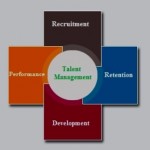
Talent Management Definition
Talent Management is a complex suite of activities and procedures for recruiting and orienting new workers, developing and retaining current employees, conducting performance assessments and appraisals, and attracting skilled and talented people to work for a business organization. It is also a program designed and managed by the HR department to provide the organization with professional workforce able to fit into the corporate environment and bring a benefit to the organization.
Often effective talent management acts like a coherent process which involves as the HR department as other departments and divisions of the company in recruiting, retaining, developing and controlling employees. The four steps of the process can be included as a consistent part in corporate planning practices. It’s a prioritized task of business planners and executives to provide an organization with workers who can follow the strategic direction and implement tactical decisions. Below we give a brief description of the four steps for an effective talent management process. You can follow the listed steps to provide your company with talented workforce.
Step#1: Recruitment
The first step to managing talents refers to the identification of the key leverage skill sets required for your company’s employees to move forward. In your business plan you will need to indicate the skills sets and also make a description of the core competence. This information will be used later when planning for recruitment. To take this step you must address the following issues:
- Develop very detailed and written job descriptions that include the specific competencies and skills required.
- Write a plan of behaviour-based interviewing to organize a meeting with candidates and select the best ones.
- Make an employee orientation plan that specifies how you would orientate new workers into the company’s culture, working environment, and specific job conditions.
- Be ready to assist new workers with the transition into the company.
- Set up evaluation criteria that determine efficiency and performance of new employees within the first three months of tenure.
- Make a report that shows result on employee recruitment and orientation.
Step#2: Retention
Once new talented workers have been employed, now you need to retain them. This task is best done through providing sufficient remuneration. At this step of effective talent management you need to make sure:
- Employees fit into the corporate culture. This means they clearly understand and completely share the behaviours, motives, processes, working conditions and technology requirements existing in the company.
- Employee commitment to the company. There should be a harmony in values between your company and workers.
- Close communication between managers and subordinates. Effective talent management requires managers to communicate with their subordinates for better problem solving and quick decision-making.
- Employees are involved in decision-making within the areas of their responsibilities and roles. Managing talents requires involves high performers in cross-functional projects and ensuring people that they are valuable to the company and can make a difference.
Step#3: Development
This step for managing talents requires you to provide growth & development opportunities for employees for your company. Development paves the way for growing the employees who become enabled to both their own and the company’s needs. Meanwhile there’s no organization that can afford to promise a 100% opportunity for development. But there is a workaround: you can promise of making your employees participants of a development program dedicated to improving and sharing knowledge, skills, behavior, and attitude.
In this context effective talent management requires you to make a development program that includes options for:
- Assessing competency profiles of your employees. This task requires you to investigate employee profiles to find out if there are any competency deficiencies that cause gaps in productivity and performance.
- Focusing on keeping strengths at the cutting edge.
- Arranging development opportunities such as training, mentoring, teamwork, job rotation, cross-functional exposure.
- Ensuring that all the development opportunities are linked to the strategic needs and expectations of the company.
- Linking talent management effort into a system of performance measurement and tracking.
Step#4: Performance
Identifying potential through measuring performance is one of the critical components of effective talent management. Measuring performance allows getting a big picture view of the current situation with available talents that help employees do their jobs. To establish sound performance measurement practices for managing talents, you need to step through the following:
- Set up employee roles and responsibilities along your company in order to ensure alignment of current performance with the strategy and across functions.
- Involve employees in tracking their performance through a system of performance monitoring and control.
- Set up accountability for the results actually produced by employees.
- Gather employee feedback.
- Provide awards and positive reinforcement for employees who have show better performance.
Conclusion
As you can see, effective talent management can be reached through taking the four key steps that form the process of managing talents and competencies of employees. It is highly important for organizations trying to be competitive to establish a system of tools and methods for managing talents and knowledge of their workers. The proposed model of the process can be used in those organizations. We hope this article helped you better understand the point and make decisions on implementing solutions and systems for managing employee skills and competencies.